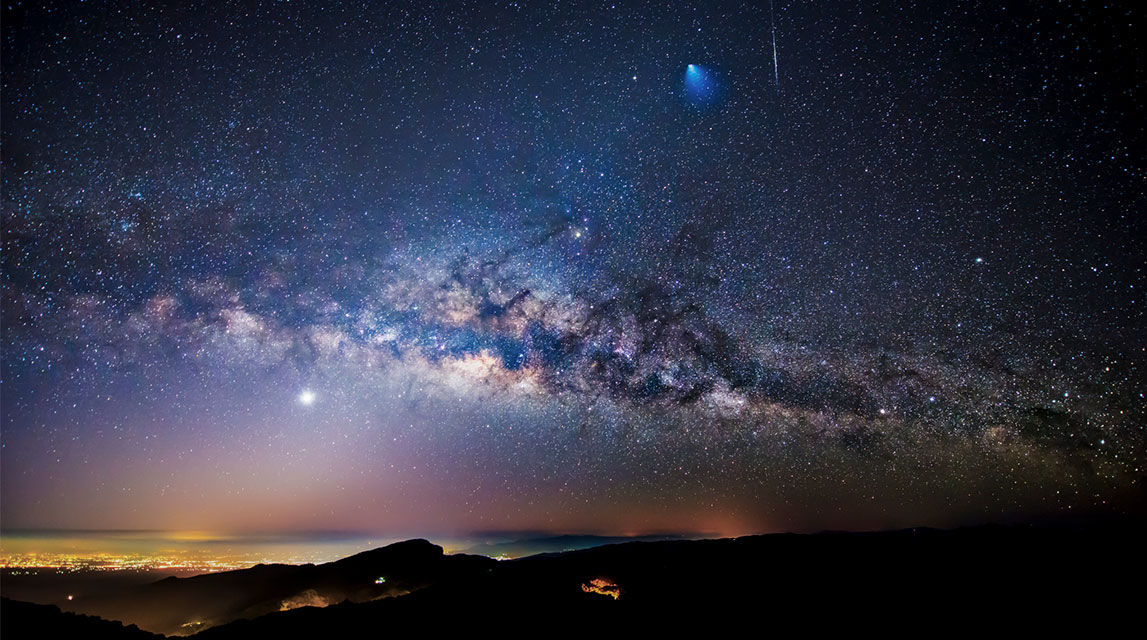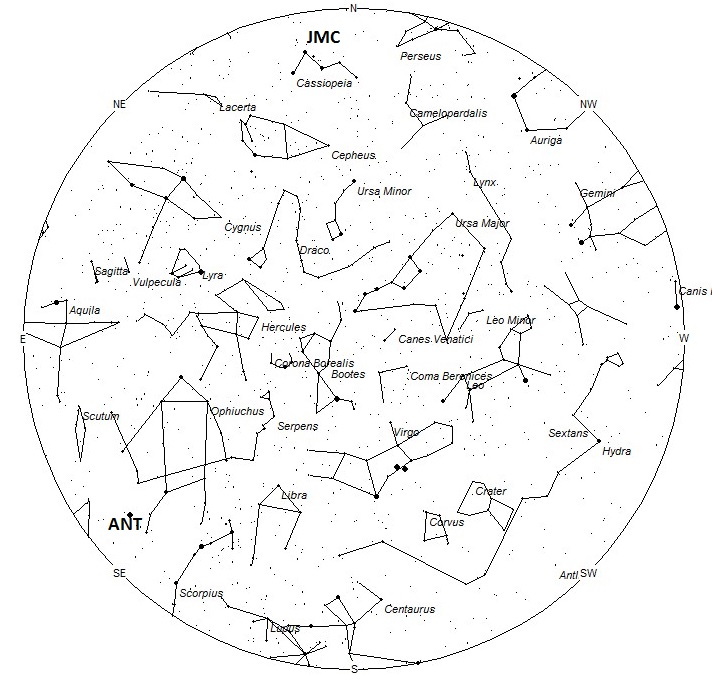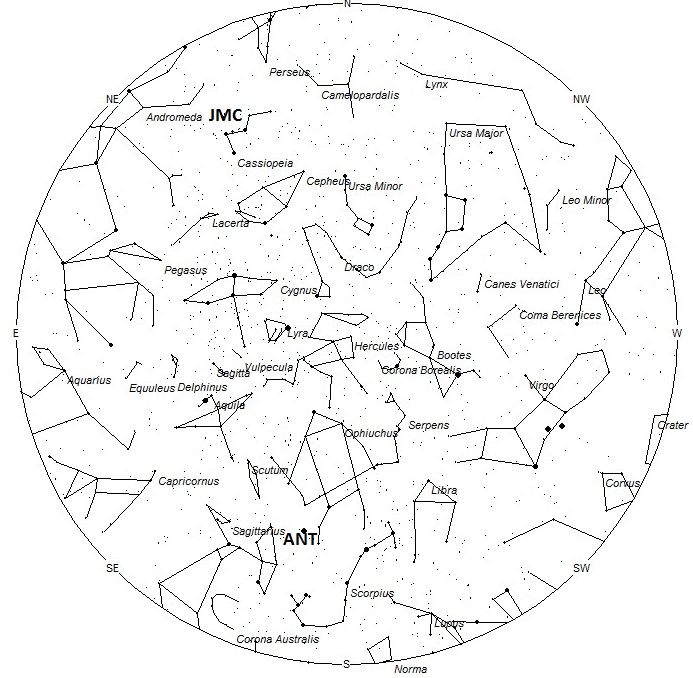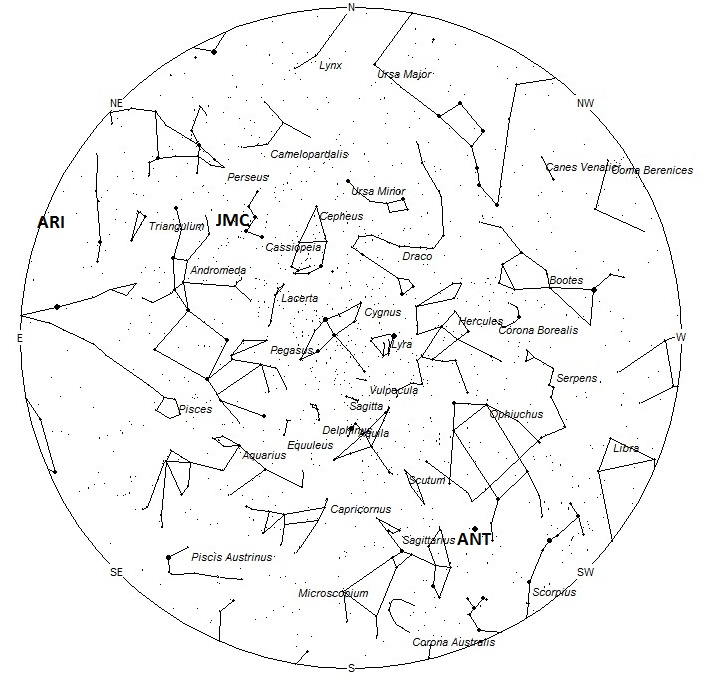
June is another slow month for meteor activity. There are no major showers active in June and only the Anthelion source can be counted on for continuous activity. Even the Anthelion radiant is located so far south this time of year that rates rarely exceed two per hour as seen from the northern hemisphere. Sporadic rates continue to remain slow as seen from the mid-northern hemisphere (45 N). As seen from the southern tropics (25 S) sporadic rates continue to be strong this month.
During this period the moon reaches its full phase on Friday June 9th. At that time the moon is located opposite the sun and will remain above the horizon all night long. This weekend the waxing gibbous moon will set during the early morning hours allowing a couple of hours of viewing under dark skies before morning twilight arrives. The estimated total hourly meteor rates for evening observers this week is near 2 for those viewing from the northern hemisphere and 3 for those located south of the equator. For morning observers the estimated total hourly rates should be near 9 as seen from mid-northern latitudes (45N) and 13 as seen from tropical southern locations (25S). The actual rates will also depend on factors such as personal light and motion perception, local weather conditions, alertness and experience in watching meteor activity. Rates during the evening hours are reduced during this period due to moonlight. Note that the hourly rates listed below are estimates as viewed from dark sky sites away from urban light sources. Observers viewing from urban areas will see less activity as only the brightest meteors will be visible from such locations.
The radiant (the area of the sky where meteors appear to shoot from) positions and rates listed below are exact for Saturday night/Sunday morning June 3/4. These positions do not change greatly day to day so the listed coordinates may be used during this entire period. Most star atlases (available at science stores and planetariums) will provide maps with grid lines of the celestial coordinates so that you may find out exactly where these positions are located in the sky. A planisphere or computer planetarium program is also useful in showing the sky at any time of night on any date of the year. Activity from each radiant is best seen when it is positioned highest in the sky, either due north or south along the meridian, depending on your latitude. It must be remembered that meteor activity is rarely seen at the radiant position. Rather they shoot outwards from the radiant so it is best to center your field of view so that the radiant lies at the edge and not the center. Viewing there will allow you to easily trace the path of each meteor back to the radiant (if it is a shower member) or in another direction if it is a sporadic. Meteor activity is not seen from radiants that are located far below the horizon. The positions below are listed in a west to east manner in order of right ascension (celestial longitude). The positions listed first are located further west therefore are accessible earlier in the night while those listed further down the list rise later in the night.
These sources of meteoric activity are expected to be active this week.
.
The center of the large Anthelion (ANT) radiant is currently located at 17:44 (266) -23. This position lies on the Ophiuchus/Sagittarius border, only 1 degree southeast of the zero magnitude planet Saturn. Due to the large size of this radiant, Anthelion activity may also appear from the nearby constellations of western Sagittarius, northern Scorpius, and southern Serpens Cauda as well as southern Ophiuchus . This radiant is best placed near 0200 local daylight saving time (LDT), when it lies on the meridian and is located highest in the sky. Hourly rates at this time should be near 2 as seen from mid-northern latitudes and 3 as seen from tropical southern latitudes. With an entry velocity of 30 km/sec., the average Anthelion meteor would be of slow velocity.
The last of the June mu Cassiopeiids (JMC) are expected this weekend. This radiant was discovered by Dr, Peter Brown and associates using data from the Canadian Meteor Orbit Radar (CMOR) installation. These meteors are active from May 31-June 5, with maximum activity occurring on June 1st. The radiant position currently lies at 01:18 (019) +55. This area of the sky lies in southeastern Cassiopeia, only 1 degree southeast of the 4th magnitude star known as Marfark (theta Cassiopeiae). These meteors are best seen near during the last dark hour of the night when the radiant lies highest in a dark sky. These meteors are better seen from the northern hemisphere where the radiant rises higher into the sky before the start of morning twilight. Hourly rates are expected to be less than 1. With an entry velocity of 42 kilometers per second, a majority of these meteors will appear to move with medium velocities.
The Daytime Arietids (ARI) are a strong shower but difficult to view due to the proximity of the radiant to the sun. These meteors are active from May 14 through June 24 with a peak on June 7. The radiant is currently located at 02:44 (041) +21. This area of the sky is located in central Aries, 8 degrees southeast of the position occupied by the 2nd magnitude star known as Hamal (alpha Arietis). The best time to view this activity is during the hour before the start of morning twilight, when the radiant lies highest in a dark sky. With the radiant low in the east it would be best to face halfway up in the sky in that same direction. With an entry velocity of 42 kilometers per second, these meteors will appear to move at a medium velocity.
As seen from the mid-northern hemisphere (45N) one would expect to see approximately 6 sporadic meteors per hour during the last hour before dawn as seen from rural observing sites. Evening rates would be near 1 per hour. As seen from the tropical southern latitudes (25S), morning rates would be near 10 per hour as seen from rural observing sites and 2 per hour during the evening hours. Locations between these two extremes would see activity between the listed figures. Evening rates during this period are reduced due to moonlight.
The list below offers the information from above in tabular form. Rates and positions are exact for Saturday night/Sunday morning except where noted in the shower descriptions.
.
| SHOWER | DATE OF MAXIMUM ACTIVITY | CELESTIAL POSITION | ENTRY VELOCITY | CULMINATION | HOURLY RATE | CLASS |
| RA (RA in Deg.) DEC | Km/Sec | Local Daylight Saving Time | North-South | |||
| Anthelions (ANT) | – | 17:44 (266) -23 | 30 | 02:00 | 2 – 3 | II |
| June mu Cassiopeiids (JMC) | Jun 01 | 00:44 (011) +53 | 42 | 09:00 | <1 – <1 | IV |
| Daytime Arietids (ARI) | Jun 07 | 02:44 (041) +21 | 42 | 11:00 | 1 – <1 | IV |
 American Meteor Society
American Meteor Society



At around 11:00 pm EST on June 3rd, 2017, I witnessed a meteor falling in Pittsfield, MA USA. Just letting all of our friends know. 🙂 It was bigger than most I have seen in the past, very fast and big, bright, with a long tail trailing behind it. It was heading toward Hinsdale, MA USA.
I can think I saw the same one huge tail very bright and it seemed to be heading the same direction based on your description I was viewing at the same direction. Very cool!!
I live in Ghana West Africa. On the night of Thursday June 8 or Friday, June 9th, I was enjoying a beautiful full moon. Suddenly I saw a large meteorite slowly arching across the sky under the gorgeously luminous full moon. It was large and very close such that I could literally see the flames of fire on the meteorite itself. I was absolutely stunned!! I’ve seen many so-called falling stars or shooting stars in my life. Never have I ever seen anything like that! It was astonishing!!
Carnita
I’ve never seen a meteor before, but I think I saw June 6, 2017 at 10:00 pm in California, MD. It seemed to be heading towards the East from the West, and was big; had a long, tail with sparks coming from it, and it lasted long enough for a friend to turn and see it after I pointed it out. It was so close, I thought it was a firework or something, but it didn’t make noise and was traveling horizontally. So cool!
I saw it too! I thought it was debris from the way it fragmented but maybe I was wrong. I’ve never seen a meteor that big!